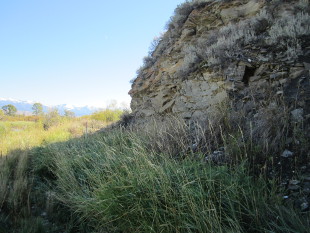 Burial siteMIKE WATERSSequencing DNA from the 12,600-year-old skeleton of an infant found in central Montana, scientists have confirmed that early Native Americans descended from ancient Asians, not from Western Europeans, according to a study published in Nature today (February 12). This work, led by ancient DNA expert Eske Willerslev of the University of Copenhagen and his colleagues, marked the first ancient North American genome to have been fully sequenced.
Burial siteMIKE WATERSSequencing DNA from the 12,600-year-old skeleton of an infant found in central Montana, scientists have confirmed that early Native Americans descended from ancient Asians, not from Western Europeans, according to a study published in Nature today (February 12). This work, led by ancient DNA expert Eske Willerslev of the University of Copenhagen and his colleagues, marked the first ancient North American genome to have been fully sequenced.
The male infant, “Anzick-1,” who was thought to have been between 12 to 18 months old when he died, was excavated in 1968 from a burial site. His skeleton is the oldest known specimen unearthed in North America belonging to the Clovis people, who populated the continent between 13,000 and 12,600 years ago. The boy was buried alongside 125 ancient artifacts including, antler tools.
Tool remains from the Clovis culture form the most widespread archaeological complex throughout North America....
“This study provides direct evidence that modern Native Americas are directly descended from populations coming from eastern Asia, probably no more than a few thousand years before Clovis,” said archaeologist David Anderson from the University of Tennessee, who was not involved in the work.
Both genetic and archeological evidence previously pointed to this conclusion, but another theory, supported only by archaeological evidence, was that ancient Native Americans came from people who migrated across the Atlantic Ocean from Western Europe before the last Ice Age—the so-called Solutrean hypothesis. “This genetic study provides unequivocal evidence that this did not happen,” said coauthor Michael Waters, a geoarcheologist at the Texas A&M University.
Anzick-1’s genome also suggests that modern Native Americans are direct descendants of the Clovis population. The ancient genome is similar to those of peoples from both North and South America, suggesting that a single founding population migrated into the Americas close to the time of the last Ice Age.
“So there is a continuity of contemporary Native American populations with this Clovis individual dating back 12,600 years ago,” said Brian Kemp, a molecular anthropologist at the Washington State University, who was not involved in the study.
Comparisons of the ancient boy’s genome with genomic data from native North, Central, and South Americans further revealed that some native North American populations may have diverged early in the history of the first American people. Additional North American genomes will be needed to trace the evolution of the people that gave rise to the modern populations of the Americas.
The researchers also showed that Anzick-1’s maternally inherited mitochondrial DNA is part of the D4a3a haplotype, a founding American lineage that is now only found in about 1.5 percent of modern Native Americans. The rare D4h3a haplotype was also identified in a 10,300-year-old specimen uncovered in Alaska in 2007.
“We now have two of the oldest skeletons in the Americans with this rare haplotype suggesting that many evolutionary processes have happened in the last 12,000 years,” said Kemp, who led to research effort on the Alaskan specimen.
“This study, like other recent studies of ancient genomes, shows that genetic patterns have changed over time, and we must be cautious about inferring ancient patterns of human genetic variation from present-day patterns,” said molecular anthropologist Deborah Bolnick from the University of Texas at Austin.
Going forward, scientists “should now apply genomic data to understand how populations moved and evolved within the Americas,” said Anderson. “Ancient DNA studies like this will contribute to a continued better understanding of early patterns of movement and settlement of people—filling in the gaps that exist in the understanding of our species history.”
While researchers continue to debate the geographic origins of humans, it’s agreed that North and South America were among the last continents to be settled. “The Anzick boy is telling us a lot about the final chapter of the journey of our species,” said Waters.
M. Rasmussen et al. “The genome of a Late Pleistocene human from a Clovis burial site in western Montana,” Nature, doi:10.1038/nature13025, 2014.
Interested in reading more?





